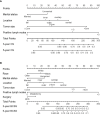Construction and Validation of Nomograms Predicting Survival in Triple-Negative Breast Cancer Patients of Childbearing Age
- PMID: 33628740
- PMCID: PMC7898905
- DOI: 10.3389/fonc.2020.636549
Construction and Validation of Nomograms Predicting Survival in Triple-Negative Breast Cancer Patients of Childbearing Age
Abstract
Background: Triple-negative breast cancer (TNBC) is one of the most aggressive subtypes of breast cancer with poorest clinical outcomes. Patients of childbearing age have a higher probability of TNBC diagnosis, with more demands on maintenance and restoration of physical and psychosocial function. This study aimed to design effective and comprehensive nomograms to predict survival in these patients.
Methods: We used the SEER database to identify patients with TNBC aged between 18 and 45 and randomly classified these patients into a training (n=2,296) and a validation (n=2,297) cohort. Nomograms for estimating overall survival (OS) and breast cancer-specific survival (BCSS) were generated based on multivariate Cox proportional hazards models and competing-risk models in the training cohort. The performances of the nomograms were quantified in the validation cohort using calibration curves, time-dependent receiver operating characteristic (ROC) curves and Harrell's concordance index (C-index).
Results: A total of 4,593 TNBC patients of childbearing age were enrolled. Four prognostic factors for OS and six for BCSS were identified and incorporated to construct nomograms. In the validation cohort, calibration curves showed excellent agreement between nomogram-predicted and actual survival data. The nomograms also achieved relatively high Harrell's C-indexes and areas under the time-dependent ROC curves for estimating OS and BCSS in both training and validation cohorts.
Conclusions: Independent prognostic factors were identified, and used to develop nomograms to predict OS and BCSS in childbearing-age patients with TNBC. These models could enable individualized risk estimation and risk-adapted treatment for these patients.
Keywords: SEER; breast cancer-specific survival; childbearing age; nomogram; overall survival; prediction; prognosis; triple-negative breast cancer.
Copyright © 2021 Cui, Song and Li.
Conflict of interest statement
The authors declare that the research was conducted in the absence of any commercial or financial relationships that could be construed as a potential conflict of interest.
Figures



Similar articles
-
Development and validation of nomograms for predicting overall and breast cancer-specific survival among patients with triple-negative breast cancer.Cancer Manag Res. 2018 Nov 19;10:5881-5894. doi: 10.2147/CMAR.S178859. eCollection 2018. Cancer Manag Res. 2018. PMID: 30510456 Free PMC article.
-
Nomograms predict survival in elderly women with triple-negative breast cancer: A SEER population-based study.Technol Health Care. 2024;32(4):2445-2461. doi: 10.3233/THC-231240. Technol Health Care. 2024. PMID: 38306071
-
Triple-negative breast cancer survival prediction: population-based research using the SEER database and an external validation cohort.Front Oncol. 2024 Jun 10;14:1388869. doi: 10.3389/fonc.2024.1388869. eCollection 2024. Front Oncol. 2024. PMID: 38919536 Free PMC article.
-
Prognostic nomograms for young breast cancer: A retrospective study based on the SEER and METABRIC databases.Cancer Innov. 2024 Oct 25;3(6):e152. doi: 10.1002/cai2.152. eCollection 2024 Dec. Cancer Innov. 2024. PMID: 39464427 Free PMC article. Review.
-
Incorporation of clinical and biological factors improves prognostication and reflects contemporary clinical practice.NPJ Breast Cancer. 2020 Mar 25;6:11. doi: 10.1038/s41523-020-0152-4. eCollection 2020. NPJ Breast Cancer. 2020. PMID: 32219153 Free PMC article. Review.
Cited by
-
A nomogram for predicting overall survival of breast cancer with regional lymph node metastasis in young women.Transl Cancer Res. 2024 Feb 29;13(2):542-557. doi: 10.21037/tcr-23-1825. Epub 2024 Feb 22. Transl Cancer Res. 2024. PMID: 38482426 Free PMC article.
-
Outperforming Traditional Staging: A Novel Nomogram for HR-Positive Breast Cancer.Ther Clin Risk Manag. 2025 Feb 25;21:191-208. doi: 10.2147/TCRM.S485685. eCollection 2025. Ther Clin Risk Manag. 2025. PMID: 40028394 Free PMC article.
-
Construction and validation of a prognostic nomogram in metastatic breast cancer patients of childbearing age: A study based on the SEER database and a Chinese cohort.Front Oncol. 2022 Nov 25;12:999873. doi: 10.3389/fonc.2022.999873. eCollection 2022. Front Oncol. 2022. PMID: 36505800 Free PMC article.
References
-
- Garrido-Castro AC, Lin NU, Polyak K. Insights into Molecular Classifications of Triple-Negative Breast Cancer: Improving Patient Selection for Treatment. Cancer Discov (2019) 9(2):176–98. 10.1158/2159-8290.Cd-18-1177 - DOI - PMC - PubMed
-
- Sajid MT, Ahmed M, Azhar M, Mustafa QU, Shukr I, Ahmed M, et al. Age-related frequency of triple negative breast cancer in women. J Coll Physicians Surgeons–Pakistan JCPSP (2014) 24(6):400–3. - PubMed
LinkOut - more resources
Full Text Sources
Other Literature Sources

